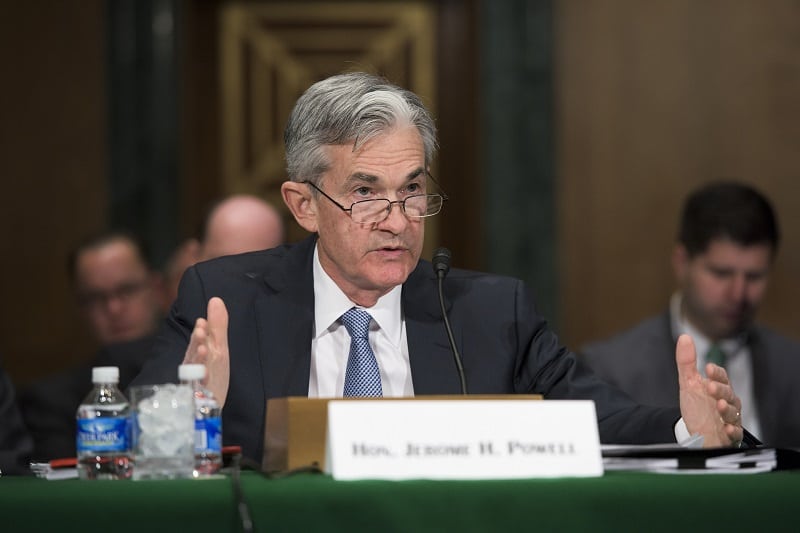In recent weeks, investors had been lulled into thinking US interest rates may settle lower than previously predicted, given the weakness in economic data and some apparent easing of inflationary pressures. This week, however, financial markets were sent into a tailspin, as they realised that the Federal Reserve was deadly serious about tackling inflation.
Following Fed chair Jay Powell’s speech at Jackson Hole, it was clear that the current run of economic bad news would not prompt a ‘pivot’ from the US central bank on interest rates, and rate rises would remain on their current trajectory.
The S&P 500 dropped over 5% in response. It is increasingly clear that there will be no gentle path to tackle inflation. The economic data will have to get a lot worse than it is today before the central bank changes direction.
Powell (pictured) was emphatic in pushing back market expectations: “Price stability is the responsibility of the Federal Reserve and serves as the bedrock of our economy. Without price stability, the economy doesn’t work for anyone. In particular, without price stability, we will not achieve a sustained period of strong labour market conditions that benefits all […]. Restoring price stability will likely require maintaining a restrictive policy stance for some time. The historical record cautions strongly against prematurely loosening policy.”
He added that the Fed’s responsibility to deliver price stability is ‘unconditional’. Equally, in spite of the global nature of this inflationary shock, “there is clearly a job to do in moderating demand to better align with supply. We are committed to doing that job”.
In reality, the hope that the Federal Reserve would pare back its rate rises on the back of weakening economic data always looked optimistic. Investors had been buoyed by last month’s inflation data, which showed a slight fall, with CPI falling from 9.1% to 8.5%, and by two quarters of negative GDP growth. They briefly hoped this may put pressure on the Federal Reserve to change course. However, the ongoing strength of the labour market and a relatively robust consumer shows that the US economy isn’t weakening sufficiently to reverse course on inflation.
Inflation ‘more embedded’ than appreciated
Ariel Bezalel, manager of the Jupiter Strategic Bond fund, said: “While forward looking indicators are pointing to slower growth, Fed policy is essentially determined by backward looking indicators on inflation and jobs. Inflation may have peaked but is still way too high for the Fed to feel comfortable yet that it’s going back to target. The July jobs number came in at a whopping 525,000, way above expectations. On top of that, the political pressure on the Fed to curb inflation ahead of the midterms is enormous.”
He says that the worst of the economic news is still to come: “The squeeze on the consumer has been well known since the war started, with food and energy prices soaring, but it will get a lot worse yet. So far this year consumers have drawn down savings and added debt to fund consumption, and headroom is running out.
“The winter will see fuel prices hit pockets hard. While at the margin oil and commodity prices are falling, it’s not enough,” he adds.
Analysis from UBS agrees that the outlook is still too uncertain for the Fed to pivot policy. It points out that the recent encouraging trends may not be sustained over the medium term. It highlights comments from Minneapolis Federal Reserve president Neel Kashkari, who said his biggest fear is that the Fed and markets are misreading the level of inflation, which could be “more embedded” at a higher level than appreciated.
UBS adds: “With inflation way too high and the labour market very tight, we see little reason for Powell to adopt a more dovish stance. Instead, the message should continue to be that the Fed is determined to restore price stability, even at the cost of economic growth. Kashkari’s remarks on Tuesday also underline this point. Markets are currently pricing in a Fed policy path that is more or less in line with the dot plot from the June FOMC meeting, which indicated rates would peak near 4%.”
The numbers don’t look bad enough yet
The problem for investors is that the most effective cure for inflation is a recession – and we’re not there yet. The environment will need to get a lot worse before it gets better, particularly on jobs data. AllianceBernstein recently suggested that a more sustainable pace for jobs would be if the economy was adding an average 100,000 positions a month.
Housing data will also be important and here, there are real signs of weakness already. Bezalel says: “Where US housing goes, the global economy goes. The affordability of US housing has collapsed to levels we haven’t seen for decades thanks to soaring mortgage rates, higher house prices and falling real incomes, and we are seeing housing data roll over: home sales are falling fast.
“It’s not just the US: housing is deteriorating in Canada, Australia, the UK, Sweden, South Korea, among others. Many of these economies have highly levered housing markets, susceptible to higher rates. The impact on housing takes time to come through, and will have a big GDP impact. Housing is 20% of US GDP.”
The Federal Reserve pivot was always more desire than reality. Investors were unlikely to see interest rates lowered before any real pain has been felt on the economy. There is a still a way to go before the US central bank reverses direction.







